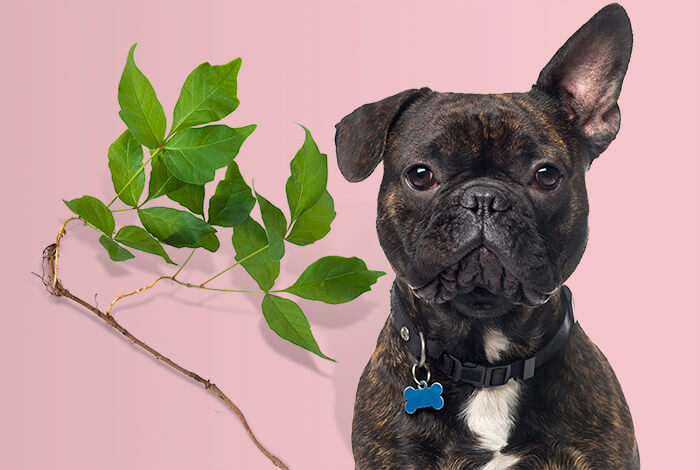![]() Reviewed By Joana Garrido DVM
Reviewed By Joana Garrido DVM
Can dogs get poison ivy? Although it rarely happens, dogs can get poison ivy if their owners are not careful. Find out the adverse effects it can cause on your pet and know what you can do if he eats or comes into contact with this plant.
What Makes Poison Ivy Dangerous to Dogs?
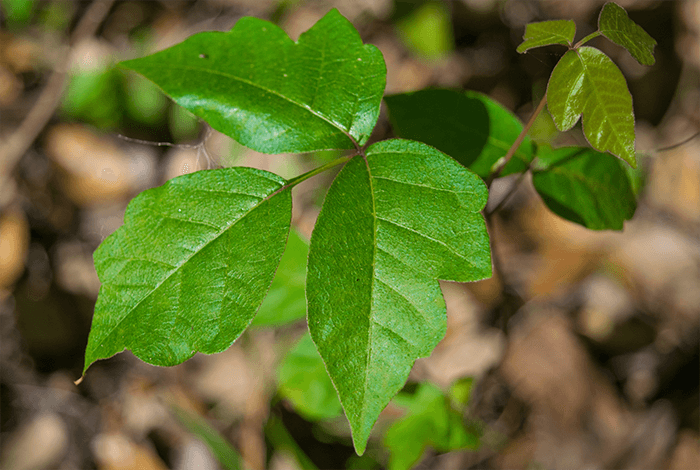
Scientifically named Toxicodendron radicans, poison ivy is infamous for causing allergic reactions upon skin contact. The culprit behind the plant’s ability to induce this type of adverse reaction is urushiol oil.
This compound comes in the form of an oily resin. Upon skin contact, its offensive chemicals react with the proteins in the skin, triggering the development of an itchy rash and painful blisters. Urushiol oil is also present in other plants, including poison oak and poison sumac.
Most dogs are unlikely to suffer from these dermatological problems if they come into contact with the plant. Their coats prevent the poison ivy’s oil from sticking to their skin.
However, hairless and thin-furred breeds do not have this level of protection. Thus, they are more vulnerable to urushiol oil skin exposure.
Small dog breeds are susceptible to the same risk. Since they are low to the ground due to their size, their bellies can easily brush against a poison ivy plant while walking.
What Happens to Dogs If They Ingest Poison Ivy?
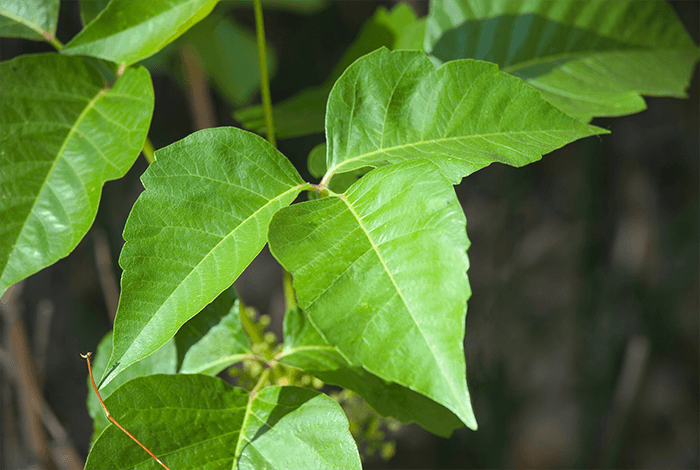
Mouth, tongue, and throat irritation might arise after a dog has ingested poison ivy, Moreover, the adverse reaction caused by the urushiol oil may trigger swelling in the throat, which can cause difficulties in swallowing and breathing.
Once the poison ivy’s plant matter reaches the digestive tract, its offensive chemicals irritate the stomach. As a result, GI upset may take place, commonly in the form of vomiting, diarrhea, and abdominal pain.
Exposure to poison ivy through direct contact or ingestion is not the only danger to watch out for. If burned, the plant’s harmful oil gets aerosolized. When inhaled, it has been reported to cause severe adverse reactions in humans.
There is a lack of evidence that poison ivy can induce the same damaging effect on dogs. However, it would be best to err on the side of caution and ensure that your dog does not inhale smoke from burnt poison ivy.
What Are the Poisonous Parts of Poison Ivy to Dogs?
Urushiol oil is present in all parts of the poisonous ivy, including its:
- Flowers
- Fruits
- Roots
- Sap
- Seeds
- Stems
However, the highest concentrations of this irritating compound can be found in the bark and leaves, especially younger foliage.
What Are Symptoms of Poison Ivy Poisoning In Dogs?
If your furry friend has ingested a poison ivy, the following clinical signs may appear:
- Stomach pain
- Vomiting
- Diarrhea
- Inflammation and redness around the lips
- Presence of sores or blisters on the mouth
- Breathing difficulties
Direct contact with the plant leads to poison ivy rash. Your dog will experience incessant itchiness, causing him to frequently bite and scratch the affected area.
In rare cases, consuming large amounts of poison ivy may trigger anaphylactic shock.
What to Do If My Dog Came Into Contact With Poison Ivy?
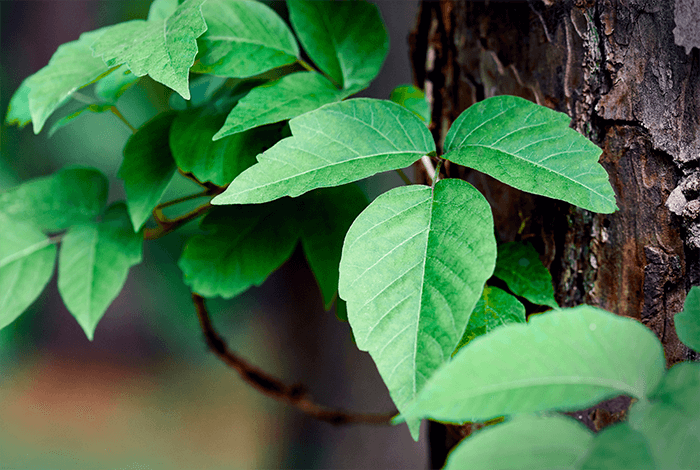
If your canine friend has ingested the plant, rinse his mouth with cool water. You can also use a clean, wet towel to wipe the affected area.
Be gentle when rubbing the cloth on his mouth to avoid exacerbating the irritation and formation of blisters.
Then proceed to bathe your dog to get rid of any urushiol oil on his coat and skin. Ideally, use oatmeal dog shampoo as it has a soothing effect on irritated skin.
Do not forget to wear gloves when bathing Fido to prevent the urushiol oil from sticking to your hands. Another preventative measure is to apply bentoquatam lotion on your hands as it serves as a protective layer on the skin.
After you have thoroughly rinsed off the shampoo and completely dried your dog, let him wear an E-collar. Doing so prevents him from scratching or biting affected areas of his body.
Do not forget to wash all items and surfaces that came into contact with the urushiol oil, like your dog’s collar, towel, and your clothes. Make sure to use a detergent product specifically designed to get rid of grease and oil.
Although poison ivy toxicity is rarely fatal, it is a good idea to contact your vet and inform them of your pet’s condition.
If your dog is exhibiting severe adverse reactions such as anaphylactic shock, bring your furry pal to an animal clinic right away for prompt medical treatment.
How to Prevent Poison Ivy Toxicity and Rashes in Dogs?
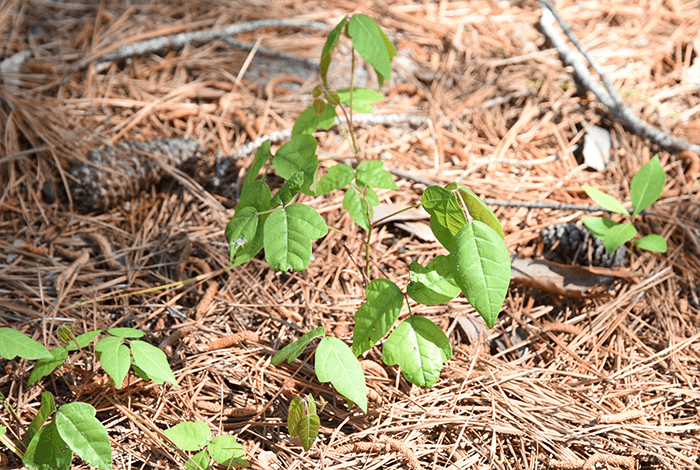
Here are some steps that you should take to protect your furry pal from the dangers of poison ivy:
- Be extra cautious when walking your dog in areas where poison ivy flourishes. The most common places are wooded areas, farms, pastures, riverbanks, and along forest edges.
- Always have your pet on a leash when walking him outdoors. Using a shorter variety is preferable, especially if you are in an unfamiliar area. It gives you more control in keeping him away from poison ivy if you come across one.
- Always bring doggy wet wipes and a disposable rubbish bag with you. This way you can quickly wipe off urushiol oil from your furry friend’s coat if he comes into contact with the plant and dispose of it properly afterward.
- If poison ivy is growing within your property, you can hire a professional to get rid of it. However, if you prefer to do it yourself, make sure to wear gloves and protective clothing to avoid getting its harmful oils on you.
- Cut down the plant’s stems using sharp shear clippers. Avoid uprooting the plant carelessly as it will release the urushiol oil and you might accidentally inhale it.
- Use a shovel to gingerly dig and remove the roots, and then apply a pet-safe weed killer on the area. Dispose of the gloves and make sure to wash your clothes in hot water.
FAQs About Can Dogs Get Poison Ivy
1. Can Dogs Spread Poison Ivy to Humans?
Poison ivy rash and toxicity is not an infectious disease. However, the harmful compound in the plant called urushiol oil can be transmitted upon skin contact, which triggers allergic dermatitis.
With this in mind, always be mindful of where you walk with your dog. Keep him on a short leash so he does not wander off to areas where poisonous ivy might grow. Most importantly, give him a thorough wipe-down after outdoor excursions.
2. Does Poison Ivy Toxicity in Dogs Go Away on Its Own?
Poison ivy toxicity in dogs can go away on its own if only a small amount of the plant is ingested.
Despite its ominous name, poison ivy is only mildly toxic to canines. Hence, its symptoms are self-limiting and often go away within a few days.
However, contact your veterinarian first and ask if it is okay not to take your furry pal to an animal clinic. They will also provide you with appropriate medications that aid in mitigating the symptoms.
3. How to Remove Poison Ivy Oil from a Dog?
You can remove poison ivy oil from a dog by meticulously bathing him. Scrub him down with an oatmeal shampoo as it helps soothe skin irritation. Make sure to wear gloves to protect your hands from the urushiol oil.
4. Can I Use Baby Wipes on a Dog with Poison Ivy Oil?
Yes, you can use baby wipes on a dog with poison ivy oil. We recommend using the unscented variety as it is less likely to contain harsh chemicals, which can worsen skin irritation.
Conclusion
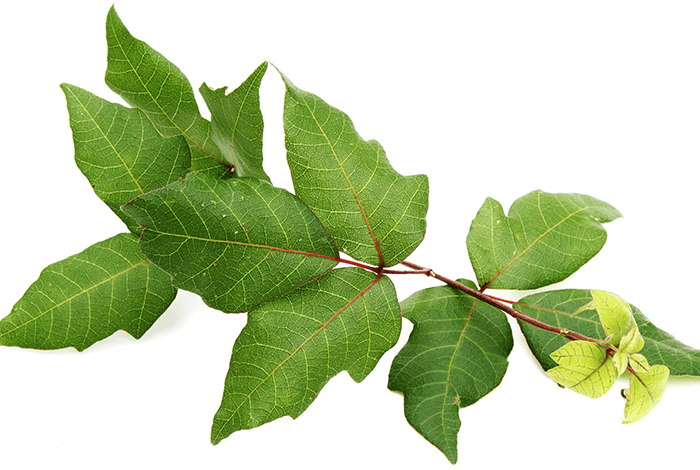
Can dogs get poison ivy? Dogs are also vulnerable to poison ivy, but less so than human beings. Their coats protect them from the plant’s harmful urushiol oil.
However, ingesting poison ivy or inhaling its oil can trigger symptoms like GI upset, skin irritation, and in the worst cases, anaphylaxis. Thus, it is highly critical to keep your pet from coming into contact with this plant.

